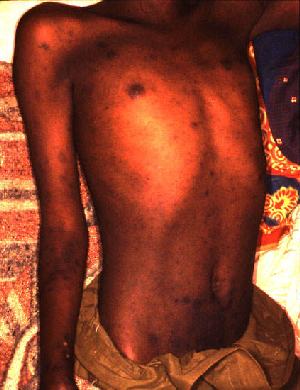Typhus
| Typhus | |
|---|---|
 |
|
| Rash caused by epidemic typhus | |
| Classification and external resources | |
| Specialty | Infectious disease |
| ICD-10 | A75 |
| ICD-9-CM | 080–083 |
| DiseasesDB | 29240 |
| MedlinePlus | 001363 |
| eMedicine | med/2332 |
| Patient UK | Typhus |
| MeSH | D014438 |
Typhus is any of several similar diseases caused by Rickettsia bacteria. The name comes from the Greek typhus (τύφος) meaning smoky or hazy, describing the state of mind of those affected with typhus. The causative organism Rickettsia is an obligate intracellular parasitic bacterium that cannot survive for long outside living cells. It is transmitted to humans via external parasites such as lice, fleas, and ticks. While "typhoid" means "typhus-like", typhus and typhoid fever are distinct diseases caused by different genera of bacteria.
The following signs/symptoms refer to epidemic typhus as it is the most important of the typhus group of diseases.
Signs and symptoms begin with sudden onset of fever, chills, headache, and other flu-like symptoms about 1 to 2 weeks after being infected. Five to nine days after the symptoms have started, a rash typically begins on the trunk and spreads to the extremities. This rash eventually spreads over most of the body, sparing the face, palms, and soles. Signs of meningoencephalitis begin with the rash and continue into the second or third weeks. Other signs of meningoencephalitis include sensitivity to light (photophobia), altered mental status (delirium), or coma. Untreated cases are often fatal.
Multiple diseases include the word "typhus" in their description. Types include:
The most effective way to prevent typhus is inoculation with the typhus vaccine series before travelling to endemic areas, and to avoid contact with lice.
The American Public Health Association recommends treatment based upon clinical findings and before culturing confirms the diagnosis. Without treatment, death may occur in 10 to 60 percent of patients with epidemic typhus, with patients over age 60 having the highest risk of death. In the antibiotic era, death is uncommon if doxycycline is given. In one study of 60 hospitalized patients with Epidemic Typhus, no patient died when given doxycycline or chloramphenicol. Some patients also may need oxygen and intravenous (IV) fluids
...
Wikipedia
